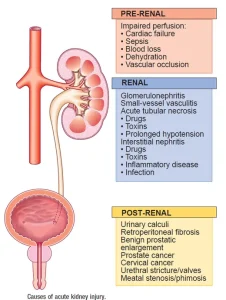Overview
Diagnosis
To diagnose acute kidney injury (AKI), your healthcare provider may recommend several tests to understand how well your kidneys are working and identify the underlying cause.
Common diagnostic tests include:
-
Blood Tests:
Blood samples are tested to check rising levels of urea and creatinine — key markers that reflect kidney function. -
Urine Output Measurement:
Monitoring urine output over 24 hours helps determine how effectively your kidneys are filtering waste. -
Urine Analysis (Urinalysis):
A urine sample may reveal signs of infections, protein, or other abnormalities that help identify the cause of kidney damage. -
Imaging Tests:
Imaging methods such as ultrasound or CT scans provide clear visuals of the kidneys and urinary tract to detect blockages or structural issues. -
Kidney Biopsy:
In some cases, your doctor may take a small tissue sample from your kidney using a needle. This test helps identify specific types of kidney disease or damage.
Related diagnostic tools:
-
CT Scan
-
Kidney Biopsy
-
Ultrasound
Treatment
Most people with acute kidney injury need hospital care. The treatment approach depends on the cause and how severely the kidneys are affected.
1. Treating the Underlying Cause
The first goal is to identify and treat the illness, injury, or medication that triggered kidney damage. This may include stopping certain drugs that affect kidney function or treating an infection or condition causing reduced blood flow to the kidneys.
2. Supporting Kidney Recovery
While your kidneys heal, your care team focuses on preventing complications and supporting recovery.
Common treatments include:
-
IV Fluid Therapy:
If dehydration or fluid loss is the cause, intravenous fluids restore the body’s fluid balance. -
Diuretics (Water Pills):
If too much fluid accumulates in the body, diuretics help remove excess water and reduce swelling in arms and legs. -
Medications for Potassium Control:
High potassium levels can affect heart rhythm. Potassium binders like sodium zirconium cyclosilicate (Lokelma) or patiromer (Veltassa) help remove extra potassium. -
Calcium Infusions:
If calcium levels drop too low, IV calcium is given to restore balance and prevent muscle or heart complications. -
Dialysis (Temporary Kidney Support):
In severe cases, dialysis is needed to filter waste and excess fluids from the blood while the kidneys recover. It also helps remove dangerous levels of potassium.
Advertisement

